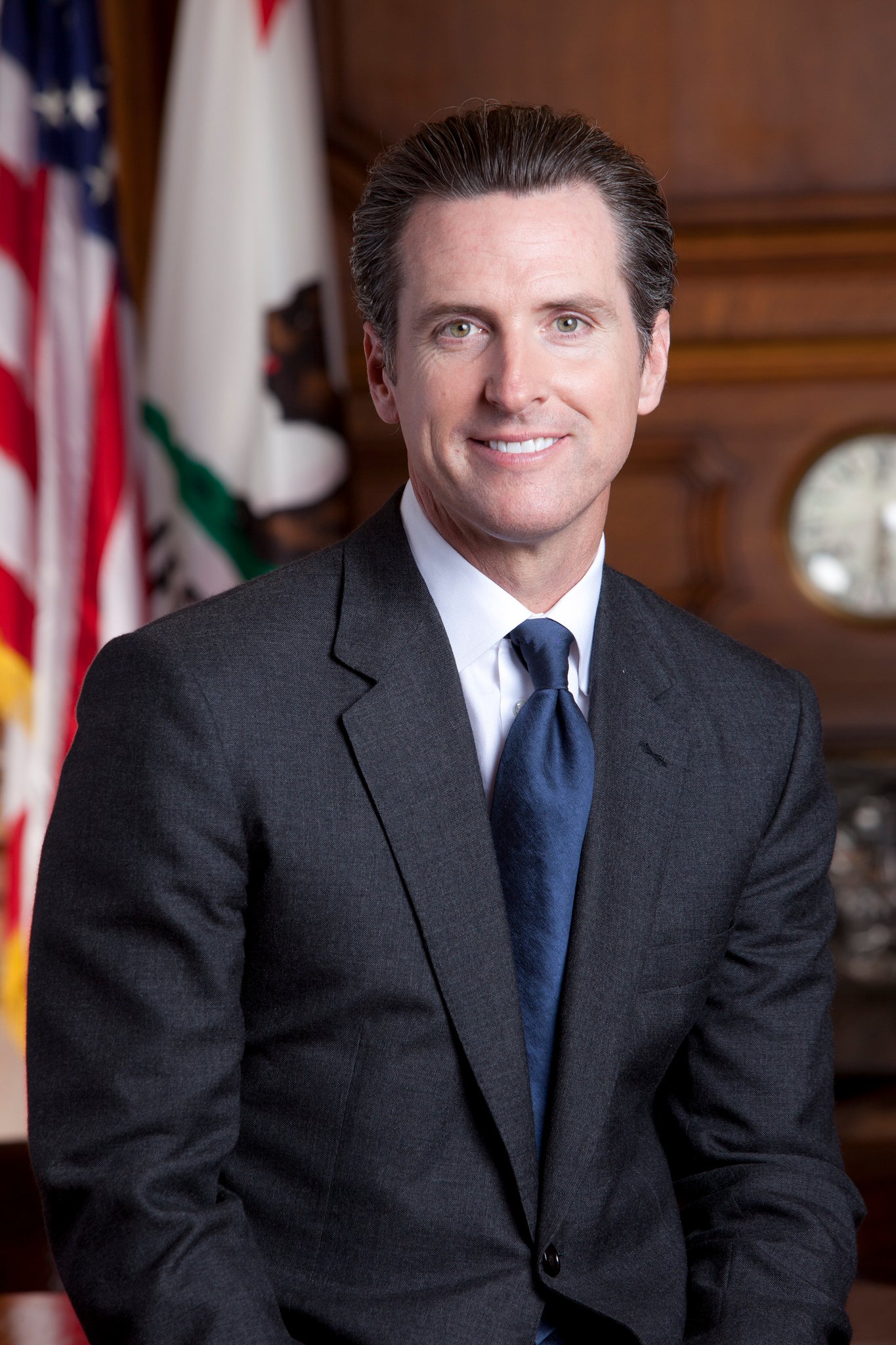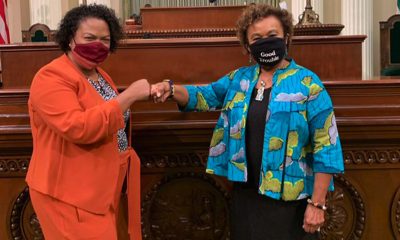Bay Area
Gov. Gavin Newsom Breaks Record With Tens-of-Billions Spending Plan for Public Schools and Community Colleges

On Jan. 10, Gov. Gavin Newsom unveiled his record $222 Billion state budget for 2020-21. The $84 billion he allocated in it for K-12 schools and community colleges represents a historic high level of funding for education in California.
The proposed investment in K-14 education is 3.03 percent or $3.8 billion more than last year. Total K-12 expenditures from all sources in the budget are projected to be $17,964 per pupil.
While state spending on education is at its highest level numerically, Governor Newsom expressed that none of them are “spiking the ball” because education outcomes for many students are not where they should be
“We are making progress, but it is stubborn and slow. We have disparities that are being closed and disparities that are persistent,” said Newsom.
The achievement gap is being closed for Latinx students, students with disabilities, low income students, and African-American students in some metrics. Latinx students narrowed their gap in English language arts scores and high school graduation rates. Students with disabilities made the greatest gains in math and English language arts. African-American students showed the largest graduation rate gain among student groups.
Where progress has been slow has been with students with disabilities, youth in foster care, homeless youth, and African-American students continuing to score below the state standard on English language arts and math tests.
Newsom was very candid in pointing out that 23 low-performing, high-poverty school districts have an over-representation of African-American students.
“It seems self evident that we should focus and concentrate our efforts in those areas in order to address…the substance of the vexing issue as it relates to academic achievement for African-American students.”
“We have to start getting serious and do something about it. We believe the biggest achievement boost is fully prepared teachers,” Newsom said.
The governor is proposing $900.1 million to be invested in workforce investment grants, professional development grants for existing teachers, and teacher recruitment strategies.
“The plan is to build a diverse teaching workforce of stable, prepared professional teachers, including more teachers that look like their students. That’s incredibly important as related particularly to African-American achievement,” Newsom said.
The budget includes $100 million to fund $20,000 stipends for new teachers who choose to teach in high-need schools. This addresses the stubborn fact that high-poverty schools have three times as many unprepared teachers.
$300 million in grants is being made available to close the academic achievement in the lowest-performing districts.
Another $300 million is proposed to expand community schools to address students’ physical and mental health needs by establishing public-private partnerships with community services. The funds will also be used to promote parent engagement.
Special Education in the state of California is in a crisis, according to Newsom. About $900 million dollars is being allocated to increase base funding for Special Ed students, support specific teacher training, fund early diagnosing and intervention and pay for studies on how districts are delivering services to respond to the learning needs of those students.
The budget calls for establishing a new Department of Early Childhood Development to consolidate under one roof the various efforts to implement the governor’s Master Plan for Early Learning and Care, a policy initiative he announced last year.
Newsom is committed to adding 10,000 full-time preschool slots this year and providing universal preschool for all low-income 4-year-olds by the end of next year.
Education leaders’ reactions to the governor’s 2020-21 state budget presentation has been mixed.
“The Governor mentioned that students should have teachers that look more like them, and we couldn’t agree more. We look forward to having the opportunity to invest in our teacher workforce and the pipeline of future teachers coming into the profession, specifically teachers of color and in the fields of science, math, and special education,” Superintendent of Public Instruction Tony Thurmond said.
State Board of Education President Linda Darling Hammond said, “Some students spend the year in classrooms staffed by highly trained, highly prepared teachers. But many others do not.
These disparities are particularly grievous for low-income students of color. The 2020-21 budget investments in educator recruitment and professional development will help place California on solid footing moving forward as we work to build, train and support the kind of high-quality educator workforce all our students need and deserve.”
California Teachers Association President E. Toby Boyd expresses some cynicism.
“Despite California’s economy consistently expanding – now being ranked fifth-largest in the entire world – we have some of the most underfunded schools in the country,” he said. “We rank 39th in the nation in per-pupil funding. We boast the most overcrowded classrooms in the entire country.”
Los Angeles Unified Superintendent Austin Beutner said, “California’s public schools will remain woefully underfunded, especially when compared with the rest of the nation.”
“This budget proposal does not go far enough in funding supports for our most vulnerable students,” Beutner added. “Including students whose families are experiencing homelessness and students with special needs.”
The governor’s presentation begins the formal state budget process. Over the next several months, the California legislature will hold hearings on the budget and special interest groups and the public will have an opportunity to comment on various budget proposals. In mid-May the Governor will release a revised budget plan reflecting changes to spending. The budget will be finalized by the end of June 2020.
Activism
Ann Lowe: The Quiet Genius of American Couture
Lowe was born in Clayton, Alabama, into a family of gifted seamstresses. Her mother and grandmother were well-known dressmakers who created exquisite gowns for women in the area. By the time Lowe was a young girl, she was already showing extraordinary talent — cutting, sewing, and decorating fabric with a skill that far exceeded her age. When her mother died unexpectedly, Lowe – only 16 years old then – took over her mother’s sewing business, completing all the orders herself.

By Tamara Shiloh
Ann Cole Lowe, born Dec.14, 1898, was a pioneering American fashion designer whose extraordinary talent shaped some of the most widely recognized and celebrated gowns in U.S. history.
Although she designed dresses for society’s wealthiest families and created masterpieces worn at historic events, Lowe spent much of her life in the shadows — uncredited, underpaid, yet unmatched in skill. Today, she is celebrated as one of the first nationally recognized African American fashion designers and a true visionary in American couture.
Lowe was born in Clayton, Alabama, into a family of gifted seamstresses. Her mother and grandmother were well-known dressmakers who created exquisite gowns for women in the area. By the time Lowe was a young girl, she was already showing extraordinary talent — cutting, sewing, and decorating fabric with a skill that far exceeded her age. When her mother died unexpectedly, Lowe – only 16 years old then – took over her mother’s sewing business, completing all the orders herself. This early responsibility would prepare her for a lifetime of professional excellence.
In 1917, Lowe moved to New York City to study at the S.T. Taylor Design School. Although she was segregated from White students and forced to work separately, she, of course, excelled, graduating earlier than expected. Her instructors quickly recognized that her abilities were far above the typical student, especially her skill in hand-sewing, applique, and intricate floral embellishment – techniques that would become her signature.
Throughout the 1920s and 1930s, she designed gowns for high-society women in Florida and New York, operating boutiques and working for prestigious department stores. Her reputation for craftsmanship, originality, and elegance grew increasingly. She was known for creating gowns that moved beautifully, featured delicate hand-made flowers, and looked sculpted rather than sewn. Many wealthy clients specifically requested “an Ann Lowe gown” for weddings, balls, and galas.
Her most famous creation came in 1953: the wedding gown worn by Jacqueline Bouvier when she married Massachusetts Sen. John F. Kennedy. The dress – crafted from ivory silk taffeta with dozens of tiny, pleated rosettes – became one of the most photographed bridal gowns in American history. Despite this achievement, Lowe received no public credit at the time. When a flood destroyed her completed gowns 10 days before the wedding, she and her seamstresses worked day and night to remake everything – at her own expense. Her dedication and perfectionism never wavered.
She eventually opened “Ann Lowe Originals,” her own salon on New York’s Madison Avenue. She served clients such as the Rockefellers, DuPonts, Vanderbilts, and actresses like Olivia de Havilland. Yet even with her wealthy clientele, she struggled financially, often undercharging because she wanted every dress to be perfect, even if it meant losing money.
Lowe’s contributions were finally recognized later in life. Today, her exquisite gowns are preserved in museums, including the Smithsonian National Museum of African American History and Culture and the Metropolitan Museum of Art.
In the last five years of her life, Lowe lived with her daughter Ruth in Queens, N.Y. She died at her daughter’s home on Feb. 25, 1981, at the age of 82, after an extended illness.
Activism
BRIDGE Housing President and CEO Ken Lombard Scores Top Honors for Affordable Housing Leadership
The Development Company of the Year honor represents a milestone for BRIDGE Housing, which received the Gold award—its top designation—in a category that included both affordable and market-rate developers. The recognition caps what has been one of the strongest growth periods in the organization’s 42-year history.

By the Oakland Post Staff
San Francisco-based BRIDGE Housing and its president and CEO, Ken Lombard, have been named among the nation’s housing industry standouts, earning two of the top prizes at the 2025 Multi-Housing News Excellence Awards.
BRIDGE Housing was named Development Company of the Year, while Lombard received Executive of the Year, recognition that places the nonprofit affordable housing provider alongside leading national developers of both affordable and market-rate housing.
The awards were announced in New York for the accomplishments achieved during 2024.
Multi-Housing News is one of the industry’s most respected publications. Award winners are selected by a panel of housing professionals, including multifamily developers, architects, and owners.
“BRIDGE Housing is deeply honored to be recognized by Multi-Housing News and our industry peers,” Lombard said. “These awards are a testament to the high-impact, mission-driven work by BRIDGE’s exceptional team to deliver quality affordable housing and support services that empower residents to improve their lives.”
The Development Company of the Year honor represents a milestone for BRIDGE Housing, which received the Gold award—its top designation—in a category that included both affordable and market-rate developers. The recognition caps what has been one of the strongest growth periods in the organization’s 42-year history.
In 2024, BRIDGE significantly expanded its footprint across California, Oregon, and Washington. That momentum continued into 2025, with portfolio growth of 9%, including the addition of nine new communities and 1,187 new or acquired affordable housing units. The nonprofit also added three new projects to its development pipeline as it nears a portfolio of 16,000 units.
The growth reflects a broader strategy aimed at accelerating both acquisitions and ground-up development, supported by partnerships with major financial institutions and innovative capital markets strategies. BRIDGE has also emphasized high-quality design and deep community engagement as central elements of its approach.
BRIDGE became the first affordable housing developer to issue tax-exempt construction bonds for one of the largest affordable housing projects in Portland, Ore., leveraging its strong credit rating.
Earlier this year, the nonprofit launched the BRIDGE Housing Impact Fund, with a goal of investing $1 billion to preserve and create affordable housing. It also closed on $175 million in taxable general-obligation bonds after increasing the offering in response to strong investor demand.
The company’s performance also underscores the role of Lombard, who has led BRIDGE since 2021 and was honored individually for his leadership.
Under Lombard’s tenure, BRIDGE has built a new leadership team with experience drawn from both the nonprofit and private sectors, with a particular focus on what the organization describes as efforts to “break the status quo,” especially in affordable housing finance. Those initiatives have helped reduce capital and construction costs, strengthen relationships with institutional investors, and expand resident support services.
Today, BRIDGE Housing serves more than 33,000 residents across 139 communities on the West Coast.
“Ken has dedicated his career to innovative real estate solutions that improve the quality of life in underserved neighborhoods,” said Kenneth Novack, chair of BRIDGE Housing’s board of directors. “His visionary leadership and the work of our incredible team have positioned BRIDGE for long-term growth that will extend our impact throughout the West Coast.”
Founded in 1983, BRIDGE Housing has helped create more than 23,000 affordable homes with a total development cost of $6 billion.
Activism
Oakland School Board Grapples with Potential $100 Million Shortfall Next Year
The school board approved Superintendent Denise Saddler’s plan for major cuts to schools and the district office, but they are still trying to avoid outside pressure to close flatland schools.

By Post Staff
The Oakland Board of Education is continuing to grapple with a massive $100 million shortfall next year, which represents about 20% of the district’s general fund budget.
The school board approved Superintendent Denise Saddler’s plan for major cuts to schools and the district office, but they are still trying to avoid outside pressure to close flatland schools.
Without cuts, OUSD is under threat of being taken over by the state. The district only emerged from state receivership in July after 22 years.
“We want to make sure the cuts are away from the kids,” said Kampala Taiz-Rancifer, president of the Oakland Education Association, the teachers’ union. “There are too many things that are important and critical to instruction, to protecting our most vulnerable kids, to safety.”
The school district has been considering different scenarios for budget cuts proposed by the superintendent, including athletics, libraries, clubs, teacher programs, and school security.
The plan approved at Wednesday’s board meeting, which is not yet finalized, is estimated to save around $103 million.
Staff is now looking at decreasing central office staff and cutting extra-curricular budgets, such as for sports and library services. It will also review contracts for outside consultants, limiting classroom supplies and examine the possibility of school closures, which is a popular proposal among state and county officials and privatizers though after decades of Oakland school closures, has been shown to save little if any money.
-

 Activism4 weeks ago
Activism4 weeks agoIN MEMORIAM: William ‘Bill’ Patterson, 94
-

 Activism3 weeks ago
Activism3 weeks agoOakland Post: Week of November 19 – 25, 2025
-

 #NNPA BlackPress4 weeks ago
#NNPA BlackPress4 weeks agoBeyoncé and Jay-Z make rare public appearance with Lewis Hamilton at Las Vegas Grand Prix
-

 #NNPA BlackPress2 weeks ago
#NNPA BlackPress2 weeks agoLIHEAP Funds Released After Weeks of Delay as States and the District Rush to Protect Households from the Cold
-

 #NNPA BlackPress4 weeks ago
#NNPA BlackPress4 weeks agoLewis Hamilton set to start LAST in Saturday Night’s Las Vegas Grand Prix
-

 Alameda County2 weeks ago
Alameda County2 weeks agoSeth Curry Makes Impressive Debut with the Golden State Warriors
-

 Activism3 weeks ago
Activism3 weeks agoOakland Post: Week of November 26 – December 2, 2025
-

 #NNPA BlackPress2 weeks ago
#NNPA BlackPress2 weeks agoSeven Steps to Help Your Child Build Meaningful Connections










































